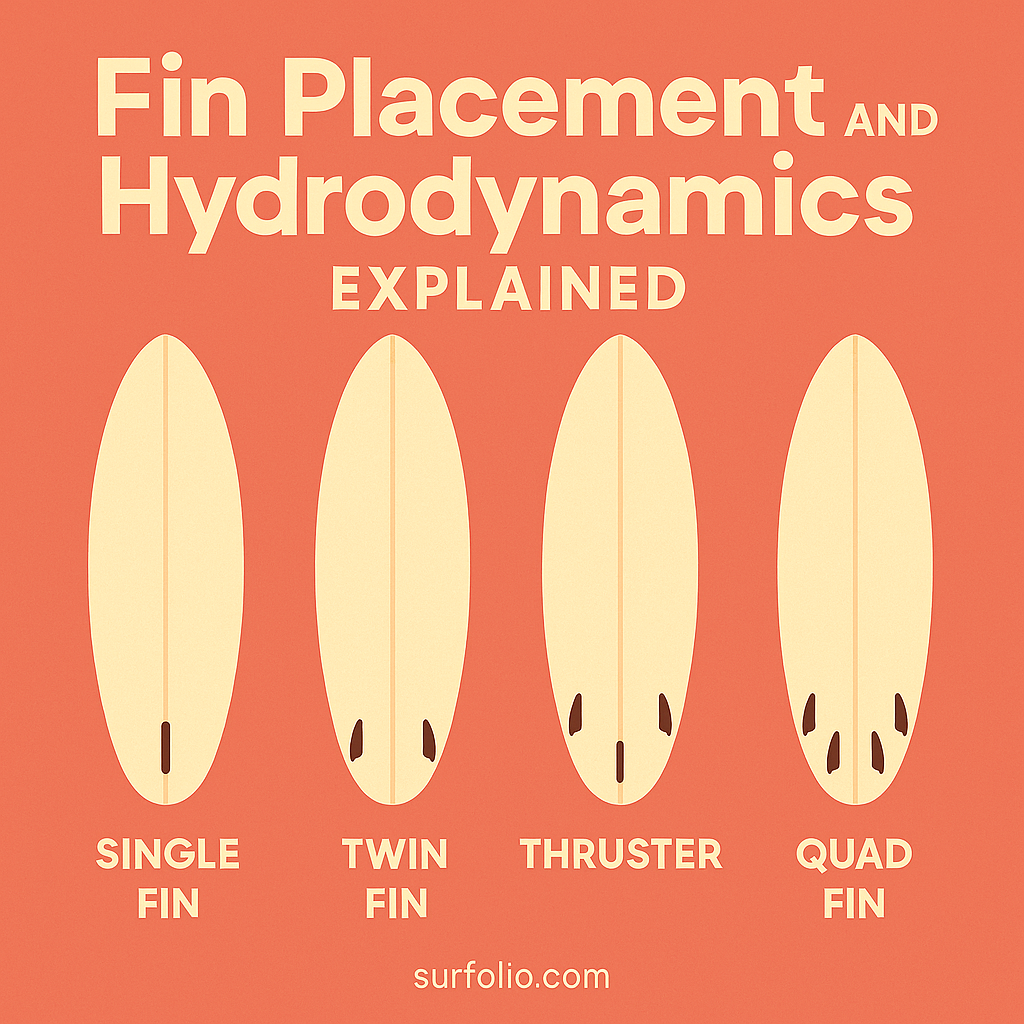
Surfboard fins are the unseen architects of every turn, carve, and line you draw on a wave. They’re what transform a flat piece of foam into a craft that can grip the face of a wave, generate speed, and respond to your slightest movement.
To truly understand surfboard performance, you have to dive into hydrodynamics — the science of how water moves around your board and fins. Whether you’re experimenting with a new setup or fine-tuning your favorite board, understanding fin placement gives you the power to customize how your board feels underfoot.
The Role of Fins in Surfboard Performance
Fins are like the rudders of a ship — they provide control, direction, and stability. Without them, your board would simply spin out.
In essence, fins:
- Add stability by preventing sideways sliding.
- Create lift that keeps your turns sharp and smooth.
- Generate drive — the forward thrust that propels you through sections.
- Influence maneuverability — how loose or tight your board feels.
The right fin setup makes the difference between a sluggish ride and one that feels like it’s flying across glass.
The Science of Hydrodynamics
Hydrodynamics is the study of how water flows around objects — in this case, your board and fins.
When you’re riding a wave, water moves beneath your board at high speed. The shape, size, and angle of your fins determine how that flow creates pressure, lift, and resistance.
Key terms to know:
- Drag: The resistance that slows the board down.
- Lift: The upward force created by angled fins that helps your board hold a line.
- Turbulence: Chaotic water movement that affects control and speed.
- Flow: Smooth water movement that increases drive and efficiency.
Balancing these forces through smart fin placement is what makes surfing feel effortless.
Common Fin Setups and Their Feel
Each fin configuration changes how a board performs in different waves.
Single Fin
Classic, smooth, and soulful. Found mostly on longboards and retro shapes.
- Feel: Stable and flowing, ideal for drawn-out turns.
- Best for: Clean, smaller waves or cruising.
Twin Fin
Fast and loose with a retro flair. Less drag, more speed down the line.
- Feel: Skatey, playful, less control in steep sections.
- Best for: Fun, smaller surf with clean faces.
Thruster (Three Fin)
The modern standard. A center fin adds drive and control, while side fins create lift.
- Feel: Balanced, predictable, great for powerful turns.
- Best for: All-around performance surfing.
Quad Fin
Four fins mean more hold and speed, especially in down-the-line waves.
- Feel: Fast and stable, ideal for barrels and point breaks.
- Best for: Hollow or fast surf.
Five Fin
A flexible setup that lets you switch between thruster and quad.
- Feel: Customizable; adjust for drive or looseness depending on the day.
- Best for: Versatile surfers who like to experiment.
Fin Placement: The Subtle Art of Balance
Small changes in fin placement can have massive effects.
- Closer to the tail: Increases responsiveness and tighter turning radius.
- Farther up: Adds control and drive but reduces looseness.
- Toed in (angled inward): Creates more drag but tighter turning ability.
- Parallel (less toe-in): Boosts speed but reduces control.
- Canted outward: Increases lift and fluidity through turns.
- Upright: Provides speed and direct, snappy response.
Even a few millimeters can shift how your board behaves in the water.
Fin Size and Flex
Beyond placement, fin size and flex change the entire feel of your board.
- Larger fins provide more hold, ideal for bigger, powerful waves.
- Smaller fins make your board looser and more responsive in smaller surf.
- Stiffer fins deliver control and precision for critical maneuvers.
- Flexible fins give a springy, flowing feel through turns.
Your weight, wave size, and surfing style all factor into the ideal balance.
Matching Fins to Board Type
- Shortboards: Typically use thruster or quad setups for control and release.
- Fish boards: Twin fins or keel fins amplify speed and fun.
- Mid-lengths: 2+1 setups (single with small sides) provide both hold and fluidity.
- Longboards: Single fins for traditional style, or side bites for added drive.
The magic lies in tuning fins to your board’s shape, your stance, and the wave’s personality.
Final Thoughts
Fin placement and hydrodynamics might sound technical, but they’re the heart of how a surfboard feels beneath your feet. Every surfer, from beginner to expert, benefits from experimenting — trying new setups, shifting fin positions, and learning how the ocean responds.
Next time you wax up your board, take a moment to look at your fins. Those small pieces of fiberglass and carbon aren’t just accessories — they’re the invisible wings that make your board come alive.
Ride with curiosity, experiment often, and let the science of water flow shape your surf journey.
